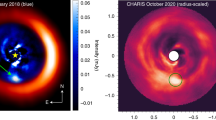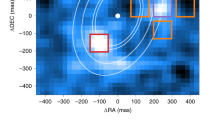Abstract
For a comprehensive understanding of planetary formation and evolution, we need to investigate the environment in which planets form: circumstellar disks. Here we present high-contrast imaging observations of V4046 Sagittarii, a 20-Myr-old close binary known to host a circumbinary disk. We have discovered the presence of rotating shadows in the disk, caused by mutual occultations of the central binary. Shadow-like features are often observed in disks1,2, but those found thus far have not been due to eclipsing phenomena. We have used the phase difference due to light travel time to measure the flaring of the disk and the geometrical distance of the system. We calculate a distance that is in very good agreement with the value obtained from the Gaia mission’s Data Release 2 (DR2), and flaring angles of α = (6.2 ± 0.6)° and α = (8.5 ± 1.0)° for the inner and outer disk rings, respectively. Our technique opens up a path to explore other binary systems, providing an independent estimate of distance and the flaring angle, a crucial parameter for disk modelling.
This is a preview of subscription content, access via your institution
Access options
Access Nature and 54 other Nature Portfolio journals
Get Nature+, our best-value online-access subscription
$29.99 / 30 days
cancel any time
Subscribe to this journal
Receive 12 digital issues and online access to articles
$119.00 per year
only $9.92 per issue
Buy this article
- Purchase on Springer Link
- Instant access to full article PDF
Prices may be subject to local taxes which are calculated during checkout



Similar content being viewed by others
Data availability
All the data are publicly available through the ESO archive (http://archive.eso.org/cms.html). The data that supports the plots within this paper and other findings of this study are available from the corresponding author upon reasonable request.
References
Garufi, A. et al. Shadows and cavities in protoplanetary disks: HD 163296, HD 141569A, and HD 150193A in polarized light. Astron. Astrophys. 568, A40 (2014).
Marino, S. et al. Compact dust concentration in the MWC 758 protoplanetary disk. Astrophys. J. 813, 76 (2015).
Stempels, H. C. & Gahm, G. F. The close T Tauri binary V 4046 Sagittarii. Astron. Astrophys. 421, 1159–1168 (2004).
Rosenfeld, K. A., Andrews, S. M., Wilner, D. J., Kastner, J. H. & McClure, M. K. The structure of the evolved circumbinary disk around V4046 Sgr. Astrophys. J. 775, 136 (2013).
Torres, C. A. O, Quast, G. R, Melo, C. H. F. & Sterzik, M. F. Handbook of Star Forming Regions Vol. II The Southern Sky (ed. Reipurth, B.) 757–812 (Astronomical Society of the Pacific, San Francisco, 2008).
Torres, C. A. O. et al. Search for associations containing young stars (SACY). I. Sample and searching method. Astron. Astrophys. 460, 695–708 (2006).
Wyatt, M. C. Evolution of debris disks. Annu. Rev. Astron. Astrophys. 46, 339 (2008).
Alexander, R. The dispersal of protoplanetary disks around binary stars. Astrophys. J. 757, L29 (2012).
Merrill, P. W. & Burwell, C. G. Additional stars whose spectra have a bright Hα line. Astrophys. J. 112, 72 (1950).
Jensen, E. L. N., Mathieu, R. D. & Fuller, G. A. The connection between submillimeter continuum flux and binary separation in young binaries: evidence of interaction between stars and disks. Astrophys. J. 458, 312 (1996).
Macintosh, B. et al. First light of the Gemini Planet Imager. Proc. Natl Acad. Sci. USA 111, 12661 (2014).
Rapson, V. A. et al. Scattered light from dust in the cavity of the V4046 Sgr transition disk. Astrophys. J. 803, L10 (2015).
Beuzit, J.-L. et al. SPHERE: a ‘Planet Finder’ instrument for the VLT. Proc. SPIE 7014, 701418 (2008).
Claudi, R. U. et al. SPHERE IFS: the spectro differential imager of the VLT for exoplanets search. Proc.SPIE 7014, 70143E (2008).
Dohlen, K. et al. The infra-red dual imaging and spectrograph for SPHERE: design and performance. Proc SPIE 7014, 70143L (2008).
Rosenfeld, K. A., Andrews, S. M., Wilner, D. J. & Stempels, H. C. A disk-based dynamical mass estimate for the young binary V4046 Sgr. Astrophys. J. 759, 119 (2012).
Benisty, M. et al. Shadows and spirals in the protoplanetary disk HD 100453. Astron. Astrophys. 597, A42 (2017).
Itoh, Y. et al. Near-infrared polarimetry of the GG Tauri a binary system. Res. Astron. Astrophys. 14, 1438–1446 (2014).
Wolff, S. G. et al. The PDS 66 circumstellar disk as seen in polarized light with the Gemini Planet Imager. Astrophys. J. 818, L15 (2016).
Debes, J. H. et al. Chasing shadows: rotation of the azimuthal asymmetry in the TW Hya disk. Astrophys. J. 835, 205 (2017).
Pohl, A. et al. Scattered light images of spiral arms in marginally gravitationally unstable discs with an embedded planet. Mon. Not. R. Astron. Soc. 453, 1768–1778 (2015).
Min, M., Stolker, T., Dominik, C. & Benisty, M. Connecting the shadows: probing inner disk geometries using shadows in transitional disks. Astron. Astrophys. 604, L10 (2017).
Facchini, S., Juhász, A. & Lodato, G. Signatures of broken protoplanetary discs in scattered light and in sub-millimetre observations. Mon. Not. R. Astron. Soc. 473, 4459–4475 (2018).
Avenhaus, H. et al. Disks around T Tauri stars with SPHERE (DARTTS-S). I. SPHERE/IRDIS polarimetric imaging of eight prominent T Tauri disks. Astrophys. J. 863, 44 (2018).
Kuruwita, R. L., Ireland, M., Rizzuto, A., Bento, J. & Federrath, C. Multiplicity of disc-bearing stars in upper Scorpius and upper Centaurus–Lupus. Mon. Not. R. Astron. Soc. 480, 5099–5112 (2018).
Chauvin, G. et al. SHINE, The SpHere INfrared survey for exoplanets. In Proc. Annual Meeting of the French Society of Astronomy and Astrophysics (eds Reylé, C. et al.) 331–335 (French Society of Astronomy and Astrophysics, 2017).
Vigan, A. et al. Photometric characterization of exoplanets using angular and spectral differential imaging. Mon. Not. R. Astron. Soc. 407, 71–82 (2010).
Pavlov, A. et al. SPHERE data reduction and handling system: overview, project status, and development. Proc. SPIE 7019, 701939 (2008).
Delorme, P. et al. The SPHERE Data Center: a reference for high contrast imaging processing. In Proc. Annual Meeting of the French Society of Astronomy and Astrophysics (eds Reylé, C. et al.) 347–361 (French Society of Astronomy and Astrophysics, 2017).
Maire, A.-L. et al. SPHERE IRDIS and IFS astrometric strategy and calibration. Proc. SPIE 9908, 990834 (2016).
Marois, C., Lafrenière, D., Doyon, R., Macintosh, B. & Nadeau, D. Angular differential imaging: a powerful high-contrast imaging technique. Astrophys. J. 641, 556–564 (2006).
Galicher, R., Marois, C., Macintosh, B., Barman, T. & Konopacky, Q. M-band imaging of the HR 8799 planetary system using an innovative LOCI-based background subtraction technique. Astrophys. J. 739, L41 (2011).
Mesa, D. et al. Performance of the VLT planet finder SPHERE. II. Data analysis and results for IFS in laboratory. Astron. Astrophys. 576, A121 (2015).
Galicher, R. et al. Astrometric and photometric accuracies in high contrast imaging: the SPHERE speckle calibration tool (SpeCal). Astron. Astrophys. 615, A92 (2018).
Avenhaus, H. et al. Structures in the protoplanetary disk of HD142527 seen in polarized scattered light. Astrophys. J. 781, 87 (2014).
Quast, G. R., Torres, C. A. O., de La Reza, R., da Silva, L. & Mayor, M. V4046 Sgr, a key young binary system. IAU Symp. 200, 28 (2000).
Donati, J.-F. et al. The close classical T Tauri binary V4046 Sgr: complex magnetic fields and distributed mass accretion. Mon. Not. R. Astron. Soc. 417, 1747–1759 (2011).
Milli, J. et al. Impact of angular differential imaging on circumstellar disk images. Astron. Astrophys. 545, A111 (2012).
Stolker, T. et al. Scattered light mapping of protoplanetary disks. Astron. Astrophys. 596, A70 (2016).
Sissa, E. et al. High-contrast study of the candidate planets and protoplanetary disk around HD100546. Preprint at https://arxiv.org/abs/1809.01001 (2018).
Maire, A.-L. et al. Testing giant planet formation in the transitional disk of SAO 206462 using deep VLT/SPHERE imaging. Astron. Astrophys. 601, A134 (2017).
Henyey, L. G. & Greenstein, J. L. Diffuse radiation in the Galaxy. Astrophys. J. 93, 70–83 (1941).
Milli, J. et al. Near-infrared scattered light properties of the HR 4796A dust ring. A measured scattering phase function from 13.6 deg to 166.6 deg. Astron. Astrophys. 599, A108 (2017).
Kama, M., Pinilla, P. & Heays, A. N. Spirals in protoplanetary disks from photon travel time. Astron. Astrophys. 593, L20 (2016).
Acknowledgements
We thank the ESO Paranal Staff for support for conducting the observations. E.S., R.G., D.M. and S.D. acknowledge support from the ‘Progetti Premiali’ funding scheme of the Italian Ministry of Education, University, and Research. D.M. acknowledges support from the ESO-Government of Chile Joint Committee program ‘Direct imaging and characterization of exoplanets’. E.R. is supported by the European Union’s Horizon 2020 research and innovation programme under the Marie Skłodowska-Curie grant agreement no. 664931. This work has been supported by the project PRIN-INAF 2016 The Cradle of Life—GENESIS-SKA (General Conditions in Early Planetary Systems for the rise of life with SKA). A.Z. acknowledges support from the CONICYT + PAI/Convocatoria nacional subvención a la instalación en la academia, convocatoria 2017 + Folio PAI77170087. The authors acknowledge financial support from the Programme National de Planétologie (PNP) and the Programme National de Physique Stellaire (PNPS) of CNRS-INSU. This work has also been supported by a grant from the French Labex OSUG@2020 (Investissements d’avenir—ANR10 LABX56). The project is supported by CNRS, by the Agence Nationale de la Recherche (ANR-14-CE33-0018). This work is partly based on data products produced at the SPHERE Data Centre hosted at OSUG/IPAG, Grenoble. We thank P. Delorme and E. Lagadec (SPHERE Data Centre) for their help during the data reduction process. SPHERE is an instrument designed and built by a consortium consisting of IPAG (Grenoble, France), MPIA (Heidelberg, Germany), LAM (Marseille, France), LESIA (Paris, France), Laboratoire Lagrange (Nice, France), INAF Osservatorio Astronomico di Padova (Italy), Observatoire de Genève (Switzerland), ETH Zurich (Switzerland), NOVA (Netherlands), ONERA (France) and ASTRON (Netherlands) in collaboration with ESO. SPHERE was funded by ESO, with additional contributions from CNRS (France), MPIA (Germany), INAF (Italy), FINES (Switzerland) and NOVA (Netherlands). SPHERE also received funding from the European Commission Sixth and Seventh Framework Programmes as part of the Optical Infrared Coordination Network for Astronomy (OPTICON) under grant no. RII3-Ct-2004-001566 for FP6 (2004-2008), grant no. 226604 for FP7 (2009-2012) and grant no. 312430 for FP7 (2013-2016). This work made extensive use of the SIMBAD and NASA ADS databases.
Author information
Authors and Affiliations
Contributions
V.D’O., R.Gr., S.De., H.A., T.St., E.G., E.R., E.S. and T.Sca. analysed the SPHERE data and prepared the manuscript and the figures. D.Mo., W.B., D. Me., G.S., A.B. and A.M.L. performed the observations in 2015 and 2017. T.B., E.B., S.Da., R.Ga., J.H., J.L., M.L., A.-L.M., S.P., C.P., L.R. and T.Sch. reduced the data as part of the SPHERE Data Reduction team in the framework of the SPHERE GTO. S.B. and M.D. performed the orbital period analysis. M.Be., A.B., M.Bo., J.G., H.J.-C., M.J., Q.K., F.M., J.E.S., J.S., C.T., P.T., G.v.d.P., A.V. and A.Z. contributed to the discussion of the results with helpful and fundamental comments and suggestions. G.C. and M.F. are key people of the SHINE survey carried out with SPHERE. O.M.-N., R.R., P.R., A.R. and J.R. are SPHERE builders.
Corresponding author
Ethics declarations
Competing interests
The authors declare no competing interests.
Additional information
Publisher’s note: Springer Nature remains neutral with regard to jurisdictional claims in published maps and institutional affiliations.
Supplementary information
Supplementary Information
Supplementary Table 1, Supplementary Figures 1–4
Rights and permissions
About this article
Cite this article
D’Orazi, V., Gratton, R., Desidera, S. et al. Mapping of shadows cast on a protoplanetary disk by a close binary system. Nat Astron 3, 167–172 (2019). https://doi.org/10.1038/s41550-018-0626-6
Received:
Accepted:
Published:
Issue Date:
DOI: https://doi.org/10.1038/s41550-018-0626-6



